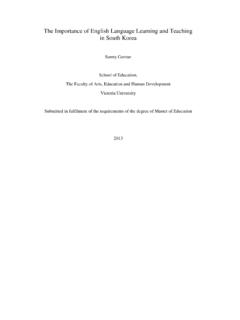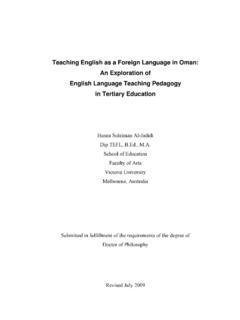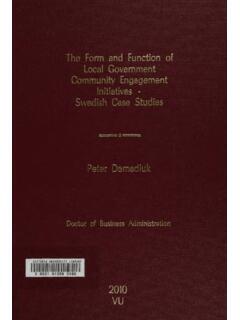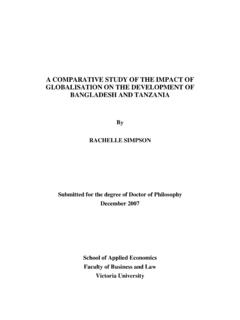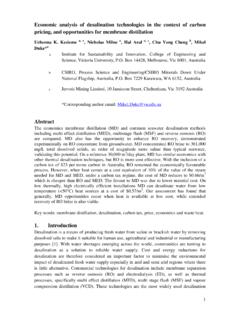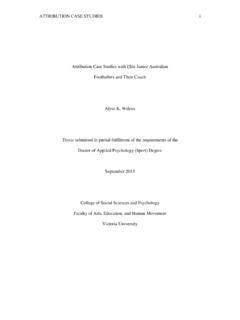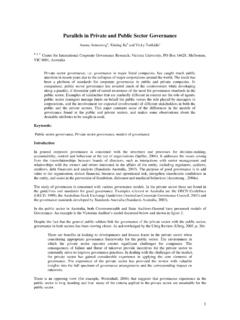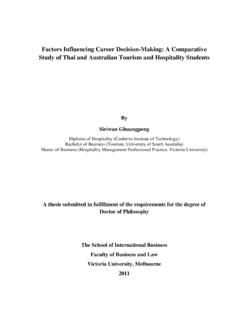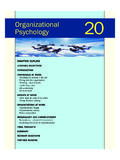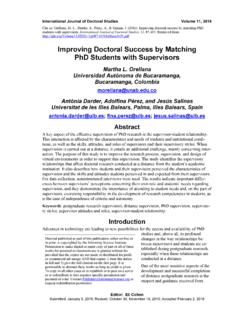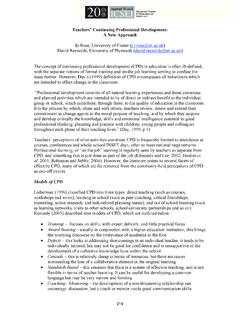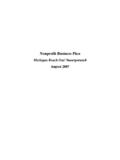Transcription of Developing a Method of Teaching Architectural Project ...
1 Developing a Method of Teaching Architectural Project Design: A Case Study of Third Year Studio Project , faculty of architecture , sriburapha university , thailand Ajaphol Dusitnanond Bachelor in architecture , Chulalongkorn university , Bangkok, thailand Architecte Diplome Par Le Gouvernement ( ). Ecole Nationale Superieure Des Beaux-Arts, Unite Pedagogique D' architecture No. 2, Paris, France A dissertation submitted in partial fulfilment of the requirements for the Degree of Doctor of Education, School of Education, faculty of Arts, Education and Human Development, Victoria university , Melbourne, Australia. 2007. Declaration I, Ajaphol Dusitnanond, declare that the Doctor of Education dissertation entitled Developing a Method of Teaching Architectural Project Design: A.
2 Case Study of Third Year Studio Project , faculty of architecture , sriburapha university , thailand , is not more than 60 000 words in length, exclusive of tables, figures, appendices, references and footnotes. This dissertation contains no material that has been submitted previously, in whole or in part, for the award of any other academic degree or diploma. Except where otherwise indicated, this dissertation is my own work. Thursday, 3 July 2007. Signed Date ii Acknowledgements I would like to acknowledge my supervisor, Dr. Ian Ling, for his great sacrifice, continued support and guidance during the entire process in writing this dissertation. I also acknowledge Dr. Chalong Tubsree, as my co- supervisor, for his suggestions and advice, as well as the students and teachers of the faculty of architecture , sriburapha university , thailand , who participated in this research.
3 In addition, I would like to express my profound gratitude to seven groups of people: firstly, to Rev. Bro. Meesak Wongprachanukul, Asst. Prof. Somchai Ekpanayakul, and Dr. Suriyan Nontasuk, who opened the opportunity for me to study in the educational field; secondly, to Dr. Roongfa Kitiyanusan and Mr. John Rubsov, who guided me during the six basic coursework elements that I undertook preparatory to writing this research;. thirdly, to Mr. Pompeyo Samaniego, Ms. Rosella Severo, and Dr. Ketsara Koetsuk, who helped me to comprehend some difficult technical texts;. fourthly, to the librarians of Assumption university , Burapha university , and Chulalongkorn university , who provided me with relevant resource material.
4 Fifthly, to the staff of A. Dusitnanond Architect & Associates Co., Ltd., and to Ms. Jenette Villegas, who provided technical and computer support;. sixthly, to Prof. Dr. John Wilson and Madame Marguerite Ling for their encouragement and moral support; finally, to my dear wife Noppawan, and to my children Pasu and Parisa, for their patience and inspiration. iii Table of Contents Declaration .. ii Table of Contents .. iv List of Tables .. ix List of Figures .. x Abstract .. xi CHAPTER 1. 1. 1. Development of the Thematic Concern .. 4. Objective of the 5. Action Research .. 5. Cooperative 7. Problem-based Learning .. 10. The Current Setting .. 11. Statement of the Problem .. 13. Significance of the Study.
5 14. Scope and Limitation of the 14. Definition of Key Terms .. 14. Structure of the Thesis .. 17. 17. CHAPTER 2. LITERATURE REVIEW .. 18. Introduction .. 18. Cooperative 18. The cooperative learning approach .. 19. Engaging in cooperative 23. Teaching cooperative learning 23. Cooperative learning strategies .. 24. Jigsaw I .. 24. Jigsaw 25. Student team and achievement divisions (STAD).. 25. Group Investigation (GI) .. 25. Student responses to cooperative learning .. 25. Rethinking the Pedagogy .. 26. A paradigm shift: From teacher- to student-centred 26. Student-centred pedagogy and learning .. 27. Student-centred versus teacher-centred 30. iv Related Approaches to 30. Problem-based learning.
6 30. Problem-based learning in 35. PBL implementation at Delft .. 37. PBL implementation at 40. Institutional and educational 41. Constructivism vs. constructionism .. 43. Action 45. Active 45. Active learning 47. Benefits of active learning to students .. 50. Collaborative learning .. 52. Task 52. Student evaluation .. 53. Group structure .. 53. Collaborative learning in architecture .. 53. Advantages of collaborative 54. Developing social 54. Stimulating individual capacities .. 55. Arousing critical 55. Collaborative approaches around the 55. A study of collaborative learning styles and team learning performance .. 57. The Professional Development of Teachers .. 58. Concepts of competence and their Implications.
7 60. Leadership for Change .. 60. Educational 61. Teaching repertoire .. 61. Mentoring and coaching .. 62. Intensive workshops .. 62. Teacher induction .. 63. Appraisal of teachers .. 63. Teacher training .. 63. Changing teachers' 64. Effective Teaching in Higher Education .. 65. Professional Learning: The Architectural Studio as a Paradigm for Reflection in 66. Action Research .. 68. Qualitative Research 71. Program 72. Forms of evaluation .. 74. Interactive 74. Theory of 75. Adult Training .. 83. Lifelong 86. The need for lifelong learning .. 88. Assessment and Accreditation in 88. 90. v CHAPTER 3. RESEARCH METHODOLOGY .. 91. Introduction .. 91. Details of the Research Process .. 93. Semi-structured interviews.
8 93. Action research phases .. 94. Action research Phase 1 .. 94. Action research Phase 2 .. 95. Student 95. Ethical 96. Respondents in the Study .. 96. Sources of Data .. 97. 99. CHAPTER 4. THE ACTION RESEARCH CYCLES: QUALITATIVE ANALYSIS .. 100. Introduction .. 100. Basis of this Analysis .. 100. Background of the Studio Project Design .. 101. Background of students entering third year Project design .. 103. My discussion with studio Project design teachers: Ajarn Pensri, Ajarn Sanan, and Ajarn Apirak .. 104. My first overall plan for studio Project 106. First Cycle of Action Research: Project Design 1 - Kindergarten .. 106. Plan to teach kindergarten Project .. 107. Action and observation 1.
9 107. In-Depth interview with three volunteer 108. The Developer's Daughter .. 109. The Landscape Architect's 109. The Tailor's Son .. 110. Reflection 1 .. 111. Action and observation 2: The way I taught the kindergarten Project .. 111. First 111. Second week .. 111. Third week .. 114. Fourth week .. 114. Fifth week .. 115. Target group responses: Kindergarten Project design .. 117. Students' opinion: Strengths of this new Method of 118. Students' opinion: Weaknesses of the new Method of Teaching 119. Students' recommendations: Changes in the studio Project design course 1 .. 119. Reflection 2 .. 120. An interview with Ajarn 120. Second Cycle of Action Research: Project Design 2 Office 122. Action and observation 3.
10 123. Reflection 3 .. 124. In-depth interview: Three volunteers from the second group .. 125. vi Reflection 4 .. 126. Interview with Ajarn 127. Reflection 5 .. 130. Students' opinion: Strengths of this new Method of Teaching 131. Students' Recommendations: Changes in the studio Project design course 2 .. 132. Project Design 3 Hospital .. 132. Action and observation 4 .. 133. In-depth Interview with three volunteers .. 133. Reflection 6 .. 134. Action and observation 5 .. 134. Reflection 7 .. 135. Feedback on cooperative learning methods from three 136. Students' opinion: Strengths of the new Method of Teaching .. 137. Students' opinion: Weaknesses of the new Method of 138. Students' Recommendations: Changes in studio design 138.
